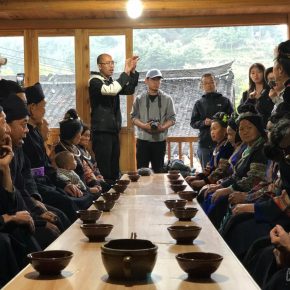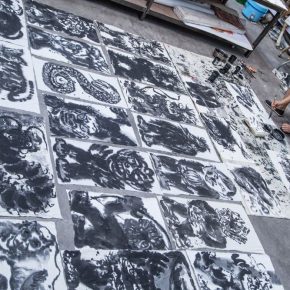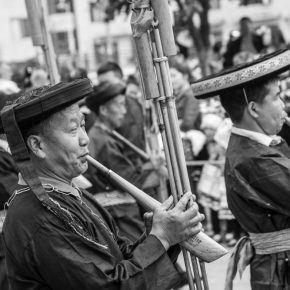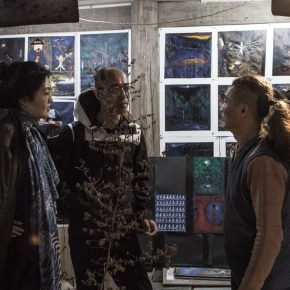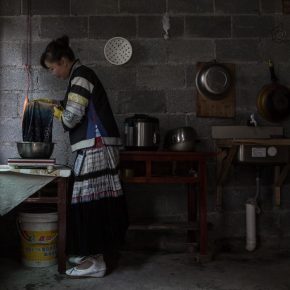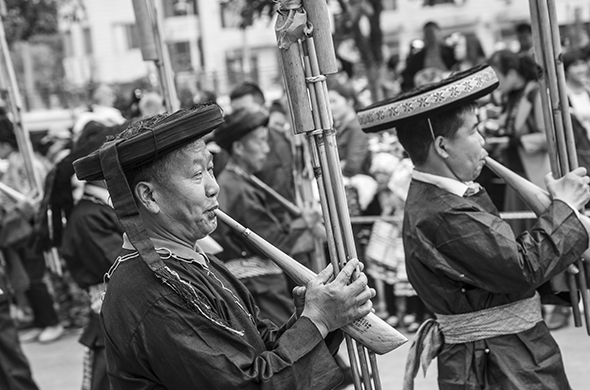
After “Where Worlds Weave: Modern Mores and Traditional Miao Values” was held at the Today Art Museum, another part of the exhibition started at the Prince Kung’s Palace Museum on 25 September. Both parts were brought together to present the values of Miao culture from multiple dimensions, and it also explored the password of translation from tradition to contemporary. It originated from the experience of the artist and Associate Prof. Wu Jian’an from the School of Experimental Art at the Central Academy of Fine Arts, who led the students to investigate the Miao region in Guizhou province. During the exhibition, Wu Jian’an was interviewed by CAFA ART INFO, and reviewed the experience and understanding from when he started the event of “Where Worlds Weave”, and he believes that it is important for the “Where Worlds Weave” to wholly grasp the core, starting point from which it originates and is infinitely growing...
Interviewer: Zhang Wenzhi (Editor, CAFA ART INFO)
Interviewee: Wu Jian’an (Artist and Associate Professor, School of Experimental Art, Central Academy of Fine Arts)
Translated by Chen Peihua and edited by Sue/CAFA ART INFO
CAFA ART INFO: Hello, Mr. Wu, the exhibition of “Where Worlds Weave” has opened to the audience, how long has it taken from the beginning of the investigation to the display on show at the exhibition, why did you start this project, what was your original intention?
Wu Jian’an: At the beginning, I had a simple idea that I hoped to find something from the traditional cultural environment and try to transform it into an exhibition of contemporary art, attempting to turn a traditional cultural element into a new lively and energetic form, which is also the working method we are familiar with, so when this started, I wanted to find a traditional art craft like embroidery and batik but I then found that there were many interesting things that we were not familiar with, such as silverware used to decorate costumes, as well as tin embroidery. When I really made it to the Miao region, I felt that it was beyond the initial idea and I felt that there were some special and key things that I have never grasped, but I didn’t know what they were. In fact, it is difficult for me to describe what they are now. It is actually a feeling, and it is an overall feeling.
Sometimes, our working methods need to deconstruct the objects, for example, I was deconstructed into different concepts such as handicrafts and materials. In the face of the cultural environment that we were familiar with, this method is more effective and is able to quickly find things that inspire emotions and energy. But in the Miao region this is an unfamiliar environment, and it is difficult for people to simply deconstruct it into embroidery or something else in order to know it. Although I think there is something wrong with it, but I am not able to say what it is.
CAFA ART INFO: You just talked about your initial thoughts and confusion when you started to research the Miao culture, how about the students from the School of Experimental Art, Central Academy of Fine Arts, who participated in the event? How much did they know about Miao culture before?
Wu Jian’an: There is no student of Miao nationality participating into this event. All students have read a lot of material and books before the visit, and I also recommended a lot of books such as catalogues of Miao embroidery and batik to all participants, so that they had a knowledge reserve in advance, and they also read some scholars’ research. But to be honest, if one does not integrate into that environment, he can’t capture the real feeling, perhaps those things are just beautiful patterns and wonderful crafts, but you can’t feel the mental sense and kernel things if you are not in that environment.
CAFA ART INFO: What we see in this exhibition is only the form of the work, while little of the history is known. We are also curious about how these works were born, which is inseparable from your feelings and practices in the Miao region. What have you and your students done in the Miao region? Would you like to share your feelings and what you harvested?
Wu Jian’an: We were all awkward when we started to investigate, which is actually related to the overall feeling that is in fact difficult to describe. In the Miao region, it takes a long time to drive to each village, even though there are highways in all counties. In the course of driving to these villages, we had many strange experiences. When the bus was going along the highway, we often saw green mountains and occasionally saw little colored blocks which were the villages where people live. Viewing the high and low mountains passing by outside the bus window, as well as the clouds on the rainy days, I hallucinated in the sense of rhythm. This sense of spatial distance and a sense of misunderstanding, combined with the comfortable natural environment, made us feel that all the rhythms were slowing down, and we gradually got used to this rhythm during a long period of field investigation.
At the same time, I also found that the Miao people living in those places spent a lot of time making clothes. Although they usually have a lot of farm work to do, I feel that their understanding of the craft is very different from ours. To a certain extent, we don’t really understand their sense of time, and it is hard for us to understand both that sense of time and the experience of spending a lot of time making clothes. Another thing that heavily impressed us was that they generously shared their favorite alcoholic drinks with strangers like us, although they were not rich. Their attitude towards material and interpersonal relationships was also a very special experience for me. People who live with this culture have different understandings and experiences on many basic levels and one can remember the art they make and all their works that are integrated with a feeling that is similar to the one of inviting strangers to drink.
CAFA ART INFO: Did Miao people’s different feelings of time, space and the material drive you to finish the works in this exhibition?
Wu Jian’an: Yes, it is very important, and it is this sense of entirety that I just spoke about. Although it is hard to tell, it is revealed in the work entitled “Big Body”. There is a story of Pangu in the mythology of Han people, and it is a similar myth of Miao people that talks about where the earth under our feet came from, which was in exchange for the bodies of ancestors who created heaven and earth. This story has become very powerful, and it made me find a point in which I can hold that feeling. In my work, the body becomes a huge thing with a head, a tent and a bamboo forest, which are all parts of the body. “Big Body” replaces the space built by white walls, and it becomes a feeling of an abstract and scattered body, in which it is possible for all things including embroidery and batik, as well as contemporary art created by students, to grow. It then becomes a living thing and becomes a relationship that can infinitely grow.
CAFA ART INFO: We have seen the enlightenment brought by Miao culture to your work. In fact, the investigation is interactive. The Miao region has its own original cultural form. Have your creative method and concept of art also brought any impact to this? I find that this exhibition invited many local craftsmen and artists from the Miao region.
Wu Jian’an: I can’t clearly declare this is the case and I don’t know what they think about us. When we were investing and doing art in the Miao region, many Miao people were very friendly, but it may not be realistic for them to understand what we were doing in that region. I am not sure whether they have ideas that are similar to ours or not, but they were really curious or very eager to know what we were doing and they would like to get involved, and I don’t know why they have this idea. Some Miao people that inherited the skills in embroidery are very open-minded, and attended our project, but they had no intention to change. They also had a lot of hesitations and fears in the process of working together with us, because what we did broke some of their original practices and boundaries, so that they felt that it was not good to do this. I think this is actually a cultural inertia or traditional inertia. If one does not do it in the original way, it might be invalidated. It is just like the students who get used to drawing and have the same fear when they are told to draw non-realistic paintings. The environment around us is relatively open, so it is easier for us to get out, but in the mountains, people rarely see new things, so they really feel anxious about any possible change in the way of thinking.
At the same time, I also feel that there is a very important thought in that place, namely the art form of Miao people is very beautiful and delicate, there is no shoddy work. However, no matter how beautiful it is, they always work inside the borders. Taking embroidery for example, people will draw a box which is embroidered inside while the surrounding area is not embroidered. I think it is related to their aesthetic psychology formed by the living environment and geographical features. It is just like the natural form of the village which I feel is composed of colorful villages that are separated by the green mountains, in the box it is the home while outside the box it is not the home, and we are used to creating at home. This existential experience determines people’s aesthetic psychology, and people really think that this clear-cut image is wonderful. And it is also related to people’s mentality. I have bought some things that I thought were beautiful in Guizhou, but I suddenly found the charm disappeared when I returned to Beijing, because the characteristics of Beijing city are different from the geographical experience of Guizhou. I believe that if there is an opportunity for Miao embroidery to leave the box, breaking through borders, it will not only change the image and aesthetics, but also change the worldview.
CAFA ART INFO: Is this a symbiotic state of traditional, national culture and contemporary art?
Wu Jian’an: Some things are seemingly separated from the modern feeling, and they also failed to be connected with the contemporary. In fact, each traditional art work must have its own different problem which is the same for the Miao people. Perhaps, I only see one side, and I hope to explore it and find a way to help Miao culture to become contemporary. Living in cities, we might feel that the closed image is not a proper form, because the geographical features of the city are completely connected, such a framed art will make people uncomfortable, so I think that the modernization of the traditional art of the Miao nationality should make some effort on this point.
CAFA ART INFO: It is also the display of the teaching of the School of Experimental Art, Central Academy of Fine Arts. The students and teachers have mature experiences in the transformation of the traditional language. Has this long-term, systematic and in-depth study brought new impetus to the teaching of the school?
Wu Jian’an: The working method of the School of Experimental Art was started by Lyu Shengzhong, who emphasizes the significance of field investigation. I had rarely traveled to the minority areas before this field investigation, and I found that the minority culture did have its special features, and I was heavily impressed by the sense of integrity. You need to enjoy a drink with them, to experience the different characteristics of life and geographical characteristics. After this is captured, you will know what the taste of their embroidery is or what the immovable things are, and what can be transformed. I think that if we have never stayed in that place nor had a deep experience, it can only present superficial things. For example, if you simply deal with it, some symbols and graphics will be taken out to be assembled in a modern way. This method is not bad, but is too easily for anyone to use, and it is short of a connotation. If one simply takes an excellent example and includes into his work after a field investigation, it is a way of grafting, which might give birth to a result or not. Therefore, one needs to go deeper and have a complete experience of it, to explore why their art is presented in that form, and you may have your own experiences, based on this I think you have a clearer direction and a firmer belief when you make a creation.
CAFA ART INFO: Part of the exhibition was held at the Today Art Museum in early September, and another part opened at the Prince Kung’s Palace Museum a few days ago. Perhaps it is separated as there is a need for more space, what is the logic for the separation? Is it about an overall planning of the exhibition?
Wu Jian’an: The part displayed at the Prince Kung’s Palace Museum mainly emphasizes on traditions and some possible ways to transform tradition into contemporary. The part in the Today Art Museum, incorporates diverse thoughts and understandings of the Miao. The expression of contemporary art does not mean that traditional handicrafts must be used, and many works failed to the use traditional handicrafts. It is mainly intended to express an experience of the object, a reflection on the culture. In the Prince Kung’s Palace Museum, we place more emphasis on how traditional handicrafts can be transformed into contemporary presentations, as well as an exploration of the contemporary creative language, which clearly displays the handicrafts of intangible cultural heritage. In short, the two parts of the exhibition have different intentions, the works at Prince Kung’s Palace Museum focus on traditions while the works at Today Art Museum pay more attention to the ways and results of traditional transformation.


